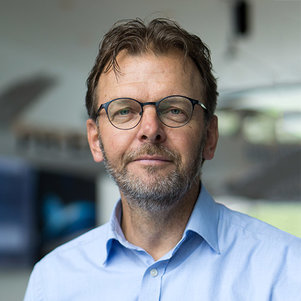Leo Veldhuis
Pollution caused by aviation is increasingly affecting the climate. In order to improve the sustainability of the sector, there is a real need for more energy-efficient aircraft designs. This is the domain of Leo Veldhuis, Professor of Flight Performance & Propulsion (FPP).
The aviation sector is growing fast: by around 5% per year worldwide, even though there are no ‘green’ solutions yet available. “If we fail to take action, aviation will account for around 30% of annual CO2 emissions by 2050. For Veldhuis, this is a key reason for investing energy in improving sustainability. “Our aim is to make major progress through improved aircraft aerodynamics, of course in co-operation with colleagues from related disciplines. In recent years, we have therefore made a large effort to join in European research projects in that field.”
Aerodynamics is part of Veldhuis's academic DNA. He spent years as a lecturer in Aerodynamics, as Associate Professor and later Head of the Wind Tunnel Laboratories. His PhD research was on propellers and propeller-wing interaction. “It is fantastic coming up with an innovative idea, creating a model for it and then predicting the benefits of the idea, followed by tests to prove that it works.” Veldhuis also likes history, the Dutch Masters and the Austrian anthropologist Heinrich Harrer. He enjoys reading books about travel and expeditions.
His research group applies knowledge of aerodynamics to improve aircraft performance. “We focus particularly on novel aircraft design and there are several interesting things in that field, at the moment. The integration of propulsion systems is one example. You can compare it to the emergence of the electric bike. The bike has stayed the same, but with electric and human propulsion. We aim to move towards electric flight. The interim phase is hybrid propulsion: a combination of electric propulsion and fuel.”
Veldhuis and his team are strongly focusing on hybrid and electric propulsion in three projects. But there are no easy answers: “In aviation, we have an aversion to weight because of its impact on fuel consumption. Unfortunately, batteries are very heavy. For this reason, the transition to electric propulsion will not be as fast as in the automotive industry. The initial focus is on small-scale aviation, where there have already been developments. For example, we are working with a company that markets small electric aircraft and hope for further fruitful collaboration.”
Another interesting fact, especially for aircraft designers, is that aircraft will look very different from what we are used to. The empennage will be different and we will see innovative integrated propulsion systems. “Research on distributed propulsion is being conducted worldwide. Rather than two kerosene-driven jet engines attached to the wing, electric engines will be distributed at intervals across the aircraft. This has numerous implications for the design, as well as flight mechanics: the aircraft will behave differently in flight, and the way aircraft are navigated will change. We are exploring this in consultation with other research groups.”
Proud
Propeller propulsion, long dismissed as outdated, is re-emerging, even internationally. “That is only logical, as it is 30% more economical than jet propulsion. Unfortunately, much of the knowledge about it worldwide has disappeared. Personally, I have never lost interest. When I obtained my PhD in 2005, I predicted that we would design large propeller aircraft at some time in the future. People laughed about this statement, but it is happening right now. There is still interest out there in my dissertation, even at NASA. Secretly, I am quite proud of that.”
Veldhuis sees electric flight as the way forward. However, there need to be further breakthroughs in battery technology. “The lighter batteries are, the further we can fly. At the same time, I have to admit: even if we manage to reduce CO2 emissions in aviation by 50%, the sector will still be strongly affecting the climate. Our technological developments cannot keep up with the enormous growth in aviation. Flying is too cheap. I do not wish to take away anyone's right to travel and consider respect for others to be crucial, but something needs to change.”
The turning point could come in what Veldhuis refers to as four-dimensional mobility. “If developing and obtaining products locally is 1D, trains, boats and cars 2D and aviation 3D, then raising awareness is 4D. Politics and the general public will need to opt for 2D and 3D mobility as smartly as possible. Many people are already deciding to stop flying, including scientists. Me too, unless there is really no alternative.”


